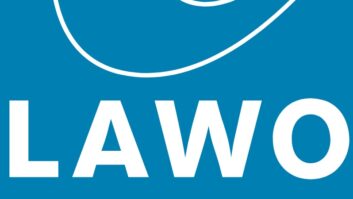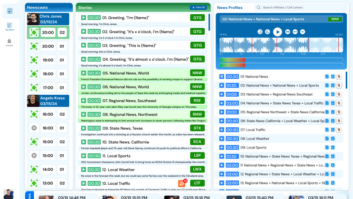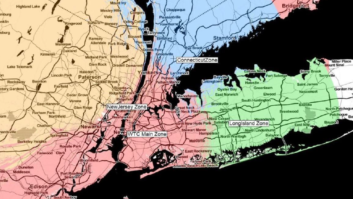NAB2000 Paper Explains Radio Free Asia’s Broadcast Open Development Exchange Initiative
As broadcasters shift to operations in the digital domain, a new dilemma faces the modern broadcast technician: how to best take advantage of rapidly evolving computer technology and stay within budgetary restrictions.
In an effort to meet this challenge, members of the Technical Operations Division of Radio Free Asia are publicly launching “The Broadcast Open Development Exchange Initiative” at NAB2000 this week in Las Vegas.
They are discussing the initiative on Tuesday, April 11, as part of the Broadcast Engineering Conference session “The Foundations of Radio: The Physical Plant.”
The initiative and corresponding Web site are being launched to serve as an open platform for the free exchange of information and technical development within the professional broadcast community.
The initiative consist of two initial projects: Radio Broadcast Open Source System, or R-Boss, and The 3d-Project.
The R-Boss is a suite of digital broadcast applications being developed and distributed under the Open Source Software, or OSS, model.
The 3d-Project is a shared distribution and exchange project of broadcast specific 3-D drawings, material and texture bitmap files.
OSS overview
Broadcast-quality gear has always maintained a distinction from consumer technology through a number of traditional features.
Typically, premium broadcast quality equipment is delivered with service manuals, essentially complete documents that allow for maintenance, repair, modification and system rework if, in a particular situation, the gear requires it. This distinguishing feature allows for heavy use in exceptional conditions with long life cycle and good reliability.
As we now occupy the networked digital age, program production, storage and transmission are more and more based on digital systems. To this end, production and transmission facilities that are maintained as state of the art are, with few exceptions, totally digital and under computer control.
The data representing programs and the data representing associated information (such as program date and content) are only distinguishable as pure bandwidth. Specific software is required to access and manipulate the program bandwidth data.
The creation of this software has been an evolutionary process with proprietary technology bases which will blossom eventually into publicly accessible standards.
Until now, we have been sensitive to this evolution because of the need to retool periodically with yet another new proprietary system in order to remain technically innovative. We may even share the feeling that getting what we want from technology is elusive, with goals always appearing to be a model release or upgrade away.
OSS changes all of this in a profound fashion.
It changes the conditions under which we obtain the computer software needed to work. When we get the software, we get the source code, the service manual of this particular technology. All that is asked is that we pay it back by adding our own “secret sauce” — whatever tooling modifications we make to the cauldron of ongoing design and innovation.
OSS comprises simple concepts that are intended to protect the usefulness of the software for posterity. Open source doesn’t just mean access to the source code.
The distribution terms of open source software must comply with the following criteria or freedoms:
-
The freedom to run the program, for any purpose;
-
The freedom to study how the program works, and adapt it to individual needs;
-
The freedom to redistribute copies so it can be used by other users;
-
The freedom to improve the program, and release those improvements to the public, so that the whole community benefits.
With a growing list of applications, open source software is proving to be adaptable, robust and reliable. A large portion of the software user community has become involved in working together to fix problems and upgrade the applications.
Users not only report bugs; they fix bugs and share the fixes. The users work together as a community to improve the software. Rather than a proprietary asset, the software becomes a shared resource.
R-Boss
According to David Baden, head of Radio Free Asia’s Technical Operations Division, the goal of the Radio Broadcast Open Source System project is to “create a self-perpetuating, continually evolving, dynamic software platform for the radio broadcaster.”
The motivating forces operating under this umbrella envision R-Boss as a suite of programs, portable to various operating systems and hardware platforms, that allow operation of a full-featured radio broadcast station.
Beyond this broad overall goal, the development team remains committed to ongoing structural adjustment. Their refined first cut divides broadcast operation newsgathering and production into the following areas:
-
Track-X, a facility scheduling and archival management program;
-
News-X, an input news source search and edit program;
-
Audio-X, a digital audio production program.
Track-X
Track-X began as a simple tool to carry a short description of what programs aired during the day. It is seen as the eventual glue that binds all of the R-Boss applications together.
Due to its database role in providing the basic program tagging and description, it is the obvious place to specify and coordinate different categories of material. These categories include time accounting, piecing together play-lists, on-air scheduling and programming summaries.
Past experience has shown that just as people are interested in using audio in any way possible, they are also interested in receiving data about how and where music and text can be used. This includes searchable audio and text archives with rapid access to old material.
This does not mean that the average user enjoys entering this information. Therefore methods have to be developed to streamline data entry as well as to ensure it is done regularly and correctly.
Some thought to security also must be involved, both to prevent external hacks into the system and to prevent one user from inadvertently erasing material of another.
While this sounds complex, it is nothing new. There are many similar open-source projects providing the capability of doing large amounts of recording Multiple Program Emission Generalities to and from compact disc (“ripping”), with database back-ends providing the jukebox function of keeping it all organized.
Ironically, it appears there are more hackers writing complex programs for personal CD collections than there are broadcast engineers writing integrated broadcast systems.
News-X
News-X is a news source application for the storage, searching and editing of incoming text-based wire-service information. This application is in use at Radio Free Asia.
It is an open platform system in which the user interface runs under any Web browser. It is multifeed- and multilingual-capable and also capable of processing News Server (e-mail) input.
William Eldridge, Radio Free Asia’s director of technical development and author of the News-X software, said, “News-X was designed as a cheap-and-easy replacement for our newsfeed system at the time, which ran on a DEC Alpha (computer) using the OpenVMS operating system.
“I had wondered why people spent so much money on systems that basically consisted of setting a speed on a serial port, reading the port, parsing the output through simple regular expressions, and providing the output in a database format.”
Today’s diverse methods in which news stories are provided — serial feed/modems, e-mail, WWW, etc. — also add to the programming challenge.
How to standardize format, specify minimum requirements for tags (i.e., Subject or Date) and even to weight sources by figures of merit — say, The New York Times vs. a local newspaper — for all these various sources?
While this may require continual fine-tuning, the existing News-X framework was developed to minimize the pain of adding new sources and to keep the overall news site maintenance effort low.
Audio-X
Audio-X was conceived as a networked digital audio broadcast system. Beta testing is taking place at Radio Free Asia.
According to William Eldridge, “This is intended to provide an open-ended modular desktop audio recorder. In its infant stages, the recorder provides single-track editing of uncompressed audio as WAV files, with a generic SQL database input of name, sampling rate, author, etc.”
(click thumbnail)Audio-X Graphical User Interface
As the system grows, Eldridge said, pieces will be added to handle MPEG Layer 2 and 3 compression, multitrack recording, various audio effects and further database integration.
“Two interesting in-band audio organization ideas to be considered for integration include the Cart Chunk ideas by people at Orban for assisting rack gear and other equipment in processing audio, and XML specifications for standardizing audio and other broadcast structure interfaces for Web-sites and databases,” he said.
“With one import of OpenSource being cooperation, we plan on leveraging the work and ideas of others to speed up development time and enlarge features.”
The eventual goal of Audio-X is to provide a digital audio system that will integrate the many ways audio data is accessed and disseminated in a modern broadcast facility.
This includes the acquisition (recording/data file transfer) and manipulation (editing) of audio data files for broadcasting, archiving and Webcasting.
The development consideration process includes convergence among various audio formats (PCM, MPEG Layers 2 and 3, WAV), organization of audio with related textual and time-based information, and allowance for automation with interoperability between various types of broadcast gear and computer equipment.
Providing a system that works seamlessly across the different common desktop systems — Unix, Windows, Mac, BeOS — and their unique graphical user interfaces is demanding, as are time constraints when dealing with networks or scheduling for distribution.
The 3d-Project
3-D computer-aided design, or CAD, allows the construction of realistic design models, which can be downloaded directly to fabrication shops for “just-in-time” manufacture at competitive pricing.
Think of a 3-D file outputting a completed broadcast facility, which arrives prepackaged on a truck. While this seems futuristic and far-fetched, it occurred in 1998 at Radio Free Asia when studios and furniture were delivered that were identical to the 3-D virtual renderings created before the bidding process was begun.
Three-dimensional CAD drawings allow for the ergonomic study and virtual walkthroughs of broadcast facility design. While this may seem extravagant on the surface, there is a growing population that has a hard time making a spatial correlation from a 2-D drawing to reality.
The closer to life your documentation can be, the larger audience you can share the facility vision with.
The potential of CAD and computer-aided manufacture, or CAM, relies on the ability to share and reuse information. The key to realizing this potential is using common organizing principles. The 3d-Project attempts to establish broadcast engineering CAD standard guidelines.
The most time-consuming task in migrating documentation to a 3-D platform is creating the numerous drawings for objects that make up a facility or flow drawing. These are the individual objects (i.e., various broadcast equipment, furnishings, etc.) that are inserted into multiple final drawings.
The availability of pre-existing 3-D object drawings will save broadcast engineers an extraordinary amount of time when migrating to a 3-D platform.
The 3d-Project serves as a free exchange clearinghouse for these 3-D object drawings. The 3d-Project Web site will also include 3-D tutorials detailed information for the standardization of file/layer naming and material/texture bitmaps.
The public availability of these drawings will encourage manufacturers to provide updated 3-D renditions of new items in their product lines that will provide time-saving access by facility managers and engineers to various templates.

Conclusion
Quality, reliable and flexible public-domain OSS platforms are springing up throughout the world. The Internet has allowed exchange of OSS software to go to levels undreamed of.
It only made sense that the cooperative nature of the Internet would spawn additional cooperation at the software development level.
The OSS model is a particularly pervasive manifestation of this miraculous cooperation. In broadcasting, the RFA-sponsored projects described here are only harbingers of good things to come.
More information on the Broadcast Open Development Exchange Initiative is available at www.techweb.rfa.org
RW welcomes other points of view.












